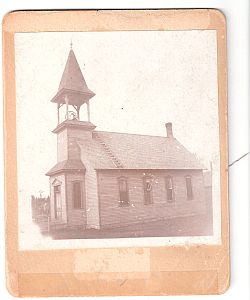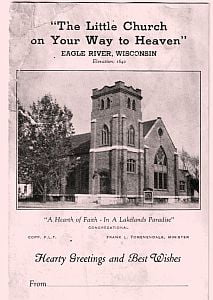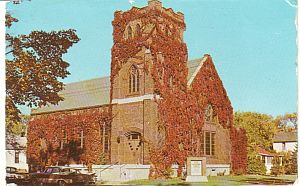The History of the First Congregational United Church of Christ, Eagle River, Wisconsin
On this page you will find several old photographs
as well as a written history.
An old sepia-tone photo of the original church building. A frame building was constructed by the Methodists in 1885 and purchased in 1887 by the Congregationalists. This building was located at the southeast corner of First and Division Streets across the road from the present church building. The approximate date of this photo is around 1887.
A postcard from 1939 welcomed visitors to “The Little Church on Your Way to Heaven”.
A postcard from around 1960 shows a view of the present church building without the educational wing to the east (right side of photo)…and covered with ivy!
History of the First Congregational United Church of Christ in Eagle River
THE BEGINNINGS – 1883
After the railroad came to Eagle River in 1883, families began arriving and a real settlement was developing. These first pioneer families realized there was a great need for establishing educational and religious facilities in the new community. The first religious services were organized as Sunday school classes led by a male congregation member and held in the settlers’ homes, businesses, the school, town hall, or Opera House. Itinerant pastors and priests of various denominations also traveled by foot, wagon or train to bring “The Word” to the small congregations.
As the congregations grew, they made plans to construct their own houses of worship and these churches became a community effort and enterprise.
The O’Connor family, who was of the Catholic faith, donated the land on which the first three churches were built in Eagle River. The Methodists built the first church in 1886 on the corner of First and Division Streets. They weren’t able to maintain it and sold it to the Congregationalists. (It is interesting to note that there never was another Methodist congregation in Eagle River.) The early churches were the center of religious as well as the social life of the community. The settlers looked to their new churches for guidance, comfort and support.
The following article is the history of the local Congregational Church as it came into existence in Eagle River.
FIRST CONGREGATIONAL UNITED CHURCH OF CHRIST
– Adapted from the minutes and records of the church compiled by Pat Stevens Anderson
Organization
On February 20, 1887, representatives of the American Missionary Society and Wisconsin Home Missionary Society met to discuss the organizing and official constituting of a church. On April 2, 1887, the Congregational Church Society was organized with nine charter members: Mr. and Mrs. Robert Stewart, Mrs. Douglas Wark, Mr. and Mrs. Samuel Walters, Mr. Jacob Klumb, Mrs. R. A. Richmond, Mr. Charles Thompson, and Mr. Seymore Ashley DeWitt.
The mission field of the Eagle River church covered twenty-three points including Sayner, Boulder Junction, Lake Oswego, and Baaken. Sunday schools were set up at various locations—Sundstein, Anvil Lake, Washington, Lincoln, Bohemian, and Mayo, many of which later became public elementary schools.
The town of Eagle River became a bustling lumber town with saw mills, lumberjacks, saloons, and the merchants that served them. Sometime in about 1890, when the Rev. H. C. Todd arrived, weekly prayer meetings were organized and a reading room was set up for “boys, strangers and men without work and in need of a place to stay.” This facility was maintained for seven years.
Church Buildings
The first church building was erected by the Methodists and sold to the Congregationalists for $200.00 and served as the church facility until 1924 when the present structure was built. The original church building became the parsonage and remained so until 1985 when it was sold and moved to another location. From that time on pastors have been given a housing allowance.
By 1924, a new church facility was needed and was built across the street from the original one. The cornerstone for this structure was laid in September of that same year. The name of the church was changed from the Congregational Church Society to the First Congregational Church of Eagle River.
In July 1965, groundbreaking ceremonies were held for a new educational wing and the cornerstone was laid in October of that year. Dedication of the R. W. Newell Educational Unit was held in May 1966. Just prior to 2000, this wing was enlarged to include new offices, music room, conference room, with additional spaces added in the basement including an elevator. Making the church building physically accessible was a priority for the congregation.
The United Church of Christ
In 1956, discussion began on the proposed merger of the Congregational churches with the Evangelical and Reformed Churches. Talk was to continue for several years and caused much dissension within the denomination with some congregations severing their connections and forming their own purely Congregational organization. In 1961, the Eagle River congregation voted to join the United Church of Christ and accept its constitution. In 1964 the name of the church was changed to include “United Church of Christ.” Later the name was amended to First Congregational United Church of Christ.
Local Cooperation and Ecumenical Involvements
For a short time, the congregation was yoked with the Community Church of St. Germain and shared a pastor. First Congregational United Church of Christ of Eagle River has also joined with other local congregations of various denominations for ecumenical Good Friday services for many years. From time to time, a Floating Chapel on the Chain of Lakes, a coffee house and many other community efforts have been co-sponsored with other congregations.
Other Organizations Within the Congregation
This congregation has always been an active organization. Barely had it begun before the women got together to form the Ladies Aid Society. By 1907, they became the Earnest Workers and in 1931 the “31 Club” branched off on their own. These ladies labored long and hard for over fifty years for the good of the church. In 1955, the Women’s Fellowship was formed and still exists today. In addition, there have been many youth groups, a Men’s Fellowship, Men’s Breakfast Club, Couple’s Club and others.
Pastors of the Congregation
Pastors who have served First Congregational United Church of Christ of Eagle River as senior or solo pastor:
1887-1892 Deacon Tibbets
L. A. Holp
A. S. Newcomb
1892-1900 H. C. Todd
1900-1902 C. W. Pinckney
1902-1906 Thomas J. Harris
1907-1910 C. W. Pinckney
1910-1912 R. E. Moss
1912-1914 William A. Griffiths
1915-1918 George H. Waters
1917-1924 William J. Davis
1924-1934 Theo C. Hargreaves
1934-1939 O. R. Thome
1939-1946 Frank C. Tomenendale
1947-1964 Raymond C. Newell
1963-1969 Harvey L. Kandler
1970-1984 John G. Morrison
1985-2000 Jeffrey G. Wartgow
2001-2006 Philip Garrison
2006-2011 Patricia M. Tucker
2012-2018 Mary Anne Biggs
2019 – 2020 Jane Cartwright
2021 to present Timothy W. Shirley
Over the past 120 years this church has been served by twenty-three pastors, dedicated members, and friends. Much has been accomplished by this congregation but the work is never done. The church will continue to live by the example set by its founders, pioneers, pastors, and member through devotion, vision, faith, and love.
Other Remembrances and Recollections of the Congregation
A recollection from Mort Cook:
Every summer the First Congregational United Church of Christ Sunday School held a picnic and those picnics were really something. It was practically a holiday with approximately half the town in attendance, regardless of their church affiliation. The Gerry Lumber Company donated the services of the “Eagle,” including a team and wagon to haul barrels of water, food, and ice to the picnic. This annual event was usually held on the north shore of Eagle Lake. Mr. Kinney would bring a fifty gallon cast iron kettle from which he would serve hot maple syrup. Some of the ladies baked biscuits on a large range brought along for that purpose. Everything was free!
History of the Churches in Eagle River as told by Ed Drager in 1987 at the Centennial Celebration of the First Congregational United Church of Christ:
When I was a youngster we had three churches in the area. There was the Lutheran church which was located on the site of the Christian Science church today. A Reverend DeYoung was a Preacher at Rhinelander who came over to Eagle River every two or three weeks to hold services in the Lutheran church. The Catholic church was located where the First National Bank used to be. Father Toplac was the Priest at that time. The First Congregational United Church of Christ was across the street to the south. Reverend Todd was the Minister.
Those memories stand out in my mind as a youngster. I remember those three churches and I remember the people who ministered to me at the time.
H. C. Todd was a minister at the First Congregational United Church of Christ. I met him and he owned a large parcel of land on the Wisconsin River. We used to go hunting there and called it “Todd’s Place.” As a matter of fact, the land that Francis Johnson owned is the land owned by Todd. Ministers made a good living even then as they were often land owners.
Henry Clay Todd was Pastor of the First Congregational United Church of Christ from June 1892 until April 1900. When he came to Eagle River he had not yet turned twenty five years of age. He was ordained in Pittsville in 1883. He was born in Newark, New Jersey, in 1857. E. C. Newcomb labored long and hard at the church prior to H. C. Todd coming to Eagle River.
H. C. Todd’s nickname was the “Lumberman’s Preacher.” He started the Reading Room in the old church building that used to be across the street from the present location. Remember, Eagle River was the end of the timber flow. Large numbers of men came here. Along with them came the “winter” brawls. They lived a riotous life.
And so the Reading Room was a shelter for lumbermen. The gospel was available in books and magazines. Also available were job descriptions for lumbermen and locations and letters from logging camps. Families were able to come here to find their loved ones. The reason for this is that once you entered a camp, for all intents and purposes you were lost.
The Reading Room also developed into the “Jail Room.” When wild lumbermen got thrown out of the saloons, drunk and helpless, they were brought here. They stayed until they sobered up! Staying here kept them safe and also made sure they did not lose their paychecks!
H. C. Todd was also the first Chamber of Commerce organizer that was called, “The Advancement Association.” New home seekers to the Northwoods could inquire here as to the availability of property. Todd also promoted the Northwoods by taking the first two exhibits about Vilas County to the state fair in Milwaukee. His diligence demonstrated to the public the possibilities for this area. This endeavor proved worthwhile.
Around the turn of the century this church grew to have a position of prestige and power in the Northwoods, aided by the help of the Eagle River and Rhinelander newspapers. Unfortunately, H. C. Todd left the church in financial despair. In 1896 his salary was $780 a year. The church had a meeting with Todd about the finances. The committee included L. J. Cook. A. G. Recision, and May Voight. “W. H.” Carter was helpful in resolving this matter. The agreement was that H. C. Todd would leave. He moved to Minnesota upon health advice from his doctor. A new pastor search committee was formed comprised of Merilyn Garrison, _________Garrison, A. G. Richison, L. J. Cook, Walsworth__________, and Mary Voight.


